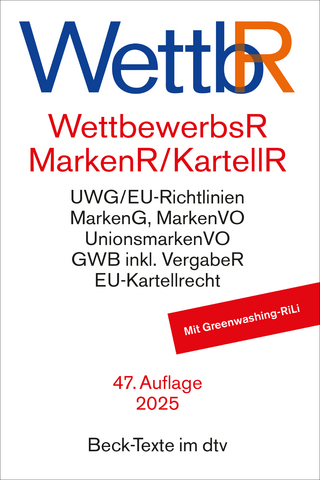
The Business of Intellectual Property
Oxford University Press Inc (Verlag)
978-0-19-533838-6 (ISBN)
- Titel ist leider vergriffen;
keine Neuauflage - Artikel merken
Christopher M. Arena is a partner in Woodcock Washburn LLP, a national intellectual property firm with offices in Atlanta, Philadelphia, and Seattle. He is the former Chief Intellectual Property Counsel at Cingular Wireless, where he was responsible for all aspects of intellectual property. Before that, he was Chief Patent Counsel at BellSouth and a founding officer of the BellSouth Intellectual Property Group of companies. He was an integral member of the deal teams that created Cingular Wireless and Cingular's subsequent merger with AT&T Wireless, the largest all-cash merger in history. Eduardo M. Carreras is of counsel with the Atlanta office of Woodcock Washburn LLP. He is the former Chief Intellectual Property Counsel of the Coca-Cola Company, where he helped establish Coca-Cola's Global Procurement Function. He also led the group responsible for managing the Coca-Cola trademark-often considered the most valuable trademark in the world-and helped the company to embark on an innovative technology and patent licensing program.
FORWARD; PREFACE; 1. Reports from the Revolution; I. Trade-Undressed - The Zeigenfelder Company (Trade dress); II. Copy Wrong and Copy Right Napster and Apple (Copyright); III. A Coke by Any Other Name The Coca-Cola Company (Trademark); IV. Securing the Borders with Patents Texas Instruments (Patent); 2. The Economics of Intellectual Property; I. Premise; II. Example; III. Economic Systems; IV. The Knowledge Economy; V. The Intellectual Property Economy; 3. Building Blocks of the Intellectual Property Economy; I. Introduction; II. The Information Hierarchy: Data, Information, Knowledge, Understanding and Wisdom; III. Qualities of Information/Knowledge; IV. Processing Information: Creativity, Invention and Innovation; V. The Currency of Intellectual Property; A. Patents; B. Trade Secrets; D. Trademarks; E. Copyrights; VI. Intellectual Capital; 4. Strategic Implications for Business; I. Introduction; II. Evolution of the Concept of Strategy; III. The Views of Business Strategy; A. External Competitive Forces; B. Internal - Competence; C. The Contingency Theory View; IV. Hierarchy of Business Strategies; A. Introduction; B. Corporate Strategy; C. Business Unit Level Strategy; D. Functional Level Strategy; E. Functional Strategies; F. Business Unit Strategies; V. Strategy Development; A. The Strategic Plan; B. The Business Model; VI. Competitive Position; A. Michael Porter; VII. Intellectual Property and Competitive Position; 5. The Economics of Innovation; I. Individual Motivation; II. Enterprise Motivations; III. Do Organizational and Individual Motivations Work Against Each Other?; IV. Economics of Innovation; 6. The Linkage Between Innovation, Business and Intellectual Property; I. Relationship of Innovation and Intellectual Property?; A. The Output of Innovation is Intellectual Property; B. Defining Success; 1. The Innovators Perspective; 2. The organizational Perspective; II. Relationship of Innovation and Business; III. Relationship of Intellectual Property and Business; IV. Forging the disciplines of innovation, intellectual property protection and business; 7. Fundamentals of Intellectual Property Strategy; I. Introduction; II. Examples of Successful Strategies; A. Trademark The Coca-Cola Company; B. Patents General Electric; C. Copyrights Walt Disney Productions; D. Trade Secrets - ; III. Assets needed to effectively compete The linkage to Business and Innovation Strategy; IV. Acquisition; A. Internal development; B. Extrenal Acquisition; C. Open Innovation; V. Protection; VI. Leverage; VII. Relation of IP Strategy to Business Strategy; 8. Acquisition Strategies; I. Sources of IP; A. Internal; B. External Sources; C. Open Innovation; II. Acquiring Internally Developed IP; A. Identifying Internally Developed IP; B. Documenting of Internally Developed IP; C. Assessing Internally Developed IP; D. Transfering Internally Developed IP; E. Communicating of Internally Developed IP; III. Acquiring IP from Outside sources; A. Identifying Outside Sources of IP; B. Documenting Externally Developed IP; C. Assessing Externally Developed IP; D. Transferring Externally Developed IP; E. Communicating Externally Developed IP; 9. Protection Strategies; I. Layering IP; II. Building a portfolio; III. Building a streamlined portfolio; IV. Examples; 10. Leveraging the Strategic Value of IP Through Enforcement; I. Enforcement; II. Competitive Intelligence; III. Enforce or License Decision; IV. Examples; A. Coca-Cola Product Substitution Program; B. Monsanto - Patent Enforcement Program; C. Disney Copyright Enforcement Program; 11. Leveraging the Strategic Value of IP Through Licensing; I. Licensing for Revenue; II. BMI and ASCAP; III. Patent Pools; IV. Licensing; V. Cross licensing; VI. Transfer; 12. Leveraging the Strategic Value of IP within the construct of economic and social policies; I. Standards Bodies; II. Securitizing; III. Auctions; IV. IP as the Business; A. Example - Lemelson; B. Example - Intellectual Ventures; V. Antitrust; VI. Public Relations; 13. International Strategies; I. International Treaties; II. Differing Legal Systems; A. Advanced (US, Europe, Japan); B. Evolving (India, Argentive); C. Rudimentary ( TBD); III. Costs; 14. Portfolio Management Strategies; I. Portfolio Theory; II. Elements of Intellectual Property Portfolio Management; A. Managing IP Investments; B. Optimizing portfolio; C. Allocating Resources; D. Managing the Pipeline; III. Examples; 15. Strategic Framework For IP Programs; I. Overview; II. Developing The Strategic Framework; III. Acquiring Intellectual Property; IV. Protecting Intellectual Property; V. Leveraging Intellectual Property; VI. Managing Intellectual Property; VII. Evolution of Straegic Framework; A. Rudimentary; B. Defensive; C. Ramp-up; D. Revenue Generating; E. Strategic; VIII. Implementing the Strategic Framework; 16. Industry Specific Strategies; I. Telecommunications; II. Information Technology; III. Pharmaceuticals; IV. Energy Production; V. Retailing; VI. Financial; VII. Examples; A. Whirlpool; B. Wrigley; C. ITW; APPENDIX; I. Intellectual Property Law for Business Owners; A. Trade Secrets; B. Trademarks; C. Trade Dress; D. Right of Publicity; E. Copyright; F. Patents; G. Design Patents; H. Mask works; TABLE OF CASES; INDEX
| Erscheint lt. Verlag | 1.8.2008 |
|---|---|
| Zusatzinfo | numerous figures |
| Verlagsort | New York |
| Sprache | englisch |
| Maße | 158 x 235 mm |
| Gewicht | 594 g |
| Themenwelt | Recht / Steuern ► EU / Internationales Recht |
| Recht / Steuern ► Wirtschaftsrecht ► Urheberrecht | |
| ISBN-10 | 0-19-533838-3 / 0195338383 |
| ISBN-13 | 978-0-19-533838-6 / 9780195338386 |
| Zustand | Neuware |
| Haben Sie eine Frage zum Produkt? |
aus dem Bereich


